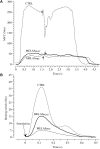Neuromuscular and Muscle Metabolic Functions in MELAS Before and After Resistance Training: A Case Study
- PMID: 31105594
- PMCID: PMC6498991
- DOI: 10.3389/fphys.2019.00503
Neuromuscular and Muscle Metabolic Functions in MELAS Before and After Resistance Training: A Case Study
Abstract
Mitochondrial encephalomyopathy, lactic acidosis, and recurrent stroke-like episodes syndrome (MELAS) is a rare degenerative disease. Recent studies have shown that resistant training (RT) can ameliorate muscular force in mitochondrial diseases. However, the effects of RT in MELAS are unknown. The aim of this case report was to investigate the effects of RT on skeletal muscle and mitochondrial function in a 21-years old patient with MELAS. RT included 12 weeks of RT at 85% of 1 repetition maximum. Body composition (DXA), in vivo mitochondrial respiration capacity (mVO2) utilizing Near-infrared spectroscopy on the right plantar-flexor muscles, maximal voluntary torque (MVC), electrically evoked resting twitch (EET) and maximal voluntary activation (VMA) of the right leg extensors (LE) muscles were measured with the interpolated twitch technique. The participant with MELAS exhibited a marked increase in body mass (1.4 kg) and thigh muscle mass (0.3 kg). After the training period MVC (+5.5 Nm), EET (+2.1 N⋅m) and VMA (+13.1%) were ameliorated. Data of mVO2 revealed negligible changes in the end-exercise mVO2 (0.02 mM min-1), Δ mVO2 (0.09 mM min-1), while there was a marked amelioration in the kinetics of mVO2 (τ mVO2; Δ70.2 s). This is the first report of RT-induced ameliorations on skeletal muscle and mitochondrial function in MELAS. This case study suggests a preserved plasticity in the skeletal muscle of a patient with MELAS. RT appears to be an effective method to increase skeletal muscle function, and this effect is mediated by both neuromuscular and mitochondrial adaptations.
Keywords: MELAS; exercise; muscle respiratory capacity; neuromuscular function; resistance training.
Figures


Comment in
-
Commentary: Neuromuscular and Muscle Metabolic Functions in MELAS Before and After Resistance Training: A Case Study.Front Physiol. 2019 Sep 13;10:1178. doi: 10.3389/fphys.2019.01178. eCollection 2019. Front Physiol. 2019. PMID: 31572223 Free PMC article. No abstract available.
References
Grants and funding
LinkOut - more resources
Full Text Sources
Miscellaneous

